You may have heard that sitting is the new smoking. Research suggests that sitting for extended periods increases the risk for diabetes and cardiovascular disease. The problem is, many of us are required to sit for long periods of time as technology straps us to the seat of computers. Then there is the fact that we are inherently lazy – why run when you can walk, why walk when you can stand, why stand when you can sit, why sit when you can slouch. It’s this intrinsic laziness that is soon becoming the downfall of evolution
Sitting Facts
- Sitting too much is the number one cause of back pain
- A 2010 American Cancer Society study that followed 123,000 adults for 13 years showed women who sat for more than six hours a day were more than 94% more likely to die during the period studied than those who were active and sat for less than 3 hours a day. For men it was 48% more likely to die than their active counterparts
- A British study of more than 4000 civil servants found that spending less than 12 hours a week sitting decreased diabetes risk by 75%
Movement & Sitting
While you may not be able to swap your desk job for one that requires you to walk or stay active all day, there is one thing you can do to improve your health right now: Sit correctly.
I actually don’t think sitting is a bad thing. Sitting ‘’too much’’ and sitting ‘’badly’’ is where the problem lies
The opposite of human movement is human rest. Rest and movement are the flipsides of the same coin. One doesn’t work without the other. As with most things in life it’s a relationship that requires both parties to ‘show up’ to synergistically and coherently thrive.
The key point I am making is that it’s a deep relationship between our movement patterns and our rest patterns.
Ask any gym goer about their fitness program and they will probably tell you about their occlusion training, undulating periodisation or some sort of new fancy protocol they are doing. Ask them about their sitting practise and they will gaze into the distance with a blank stare on their face.
If we cared as much about our rest session as we did our gym session things would look a lot rosier
Floor to stand
The first thing to note about sitting is that it is best done on the floor. All humans of all ages and cultures have spent much time sitting on the ground. On the ground is where we start with our babies developmental process. Rolling, rocking, crawling, sitting, kneeling and deep squatting all before we even attempt to stand up and walk.
Being on the ground down-regulates threat allowing for an optimal environment to ‘’safely’’ explore.
As infants we fight gravity to learn to sit and then to stand but as adults most of us give up that right. We use beds that are raised to chair height, we eat breakfast sitting on a chair, commute sitting on a chair, work sitting on a chair, go to the toilet sitting on a chair and then many sit on machines at the gym.
Getting up from the floor is an essential tonic exercise that is a direct challenge to gravity. It forces us to be mobile and stable in end ranges of motion.
But you can’t get off the ground if you never sit on the ground
Primordial Postures
These simple postures have huge benefits on our musculoskeletal system. They are a way of pressing reset. To press RESET is to re-set, to reestablish, you; your nervous system, your strength, your health. You reestablish your movement vocabulary when you revisit this early simple primordial sitting posture.
The Kneeling Posture
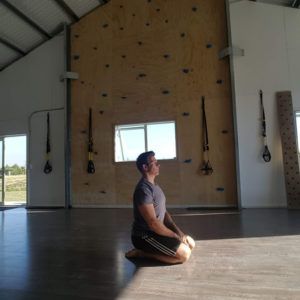
The kneeling posture is the one that we most associate with the Japanese culture. The feet are comfortably flexed and can be just touching one another or be overlapped so the convex arch of the foot rests in the concave arch of the other foot. The butt comfortably rests on the heels, the back is tall and shoulders are packed down.
If the top of the foot doesn’t comfortably rest touching the ground, this is often a sign of fascial restriction
If the butt doesn’t comfortably sit on the heels, often tight quads are the culprit
If you struggle to sit comfortably in this posture, then use a pillow under the feet or under the butt.
The goal is to comfortably sit in Japanese kneeling for a minimum of 5 minutes
Stand By Posture
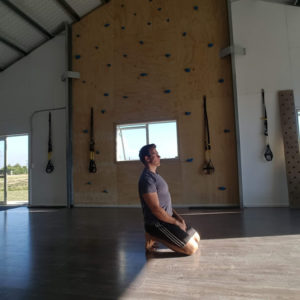
This posture is known as toe sitting or the stand by posture, as the extensor pathways are primed for movement. In the posture it is easy to push from the toes, drive the hips forward and lunge to stand.
This should be a comfortable posture similar to the kneeling posture. The toes are extended but comfortable and the butt restfully relaxes on the heels.
For many this is a difficult posture as the fascia on the soles of the feet can be tight and restricted or the toes don’t have the extension they require leading to over pressure on the metatarsal heads.
The goal of this Stand By Posture is to comfortably sit for a minimum of 5 minutes
The Half Kneeling Work Posture
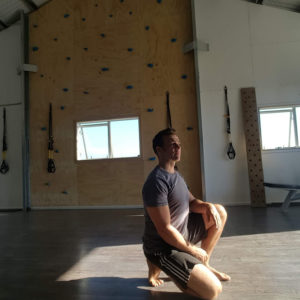
The Half Kneeling Work Posture (HKWP) is a combination of Kneeling and Squatting. It is a posture often assumed when one had to work for long periods of time.
The HKWP is often seen around one month before an infant squats and 2 months before they walk. It is critically important so we can coordinate the hip position over our center of mass at the belly button, so as not to place improper shear stresses and properly stabilize the center of mass over its base of support.
The HKWP can be performed with the rear foot in toe extension (ready position) or the rear foot flexed in single leg japanese kneeling
Aim for 5 minutes of comfortable sitting
Netflix Posture or Sphinx pose
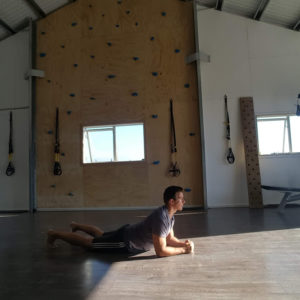
The Netflix and Chill Posture isn’t so much a sitting posture but it is an important resting posture
It’s tummy time for adults. As babies we use tummy time to develop our vestibular systems, neck control, head and eye control. We push up from the arms leaning to stabilize our shoulders in preparation for creeping and crawling. As adults it’s much the same.
This is a beautiful posture to regain some scapular control by preventing shoulder sink
The goal is to see if you can pack your shoulders into their sockets keeping your shoulders away from your ears.
The Shinbox Posture or Side Saddle
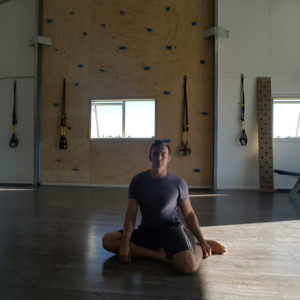
This posture is common amongst societies where it is inappropriate for women to sit with their legs apart. One leg is externally rotated from the hip and the other is internally rotated.
In my many years I have often found that many people are very comfortable on one side but tight as a drum on the other
It is critical that you are comfortable with both legs. Any asymmetries will rear their ugly head if not dealt with. If you find that one side is particularly tight spend more time finding comfort there
Office Work
I am often asked what I think of standing desks. Here is what I generally say…
On the face of them they are brilliant. BUT the problem is that if you are like most people then they simply aren’t the answer.
As I mentioned in the start of this post, we are inherently lazy. Our problem is less about sitting and more about ‘poor’ sitting mechanics. It’s no different with standing. Take a quick look around a new age office and you will see some horrible standing postures, hips swayed out, backs excessively over arched or heavily flexed, necks sticking forward and a whole host of other poor patterns
A better office set up
If you don’t have the luxury of floor sitting at work then there are still a number of ways you can make for a better office chair set up.
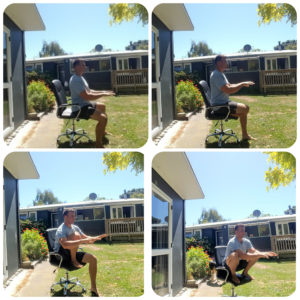
Play with a few of the above postures but make sure you keep switching the postures up. If the right leg is up for 20 minutes then make sure the left is up for 20 minutes. Chop and change as you need to keep moving and not become stagnant to your seat.
DISCLAIMER
These recommendations are not medical guidelines but are for educational purposes only.
You must consult your physician prior to starting this program or if you have any medical condition or injury that contraindicates physical activity.
This program is designed for healthy individuals 18 years and older only. The information in this report is not meant to supplement, nor replace, proper exercise training. All forms of exercise pose some inherent risks.
Paul and Krystie advise readers to take full responsibility for their safety and know their limits before practising the exercises in this program. The exercises in this program are not intended as a substitute for any exercise routine or treatment or dietary regimen that may have been prescribed by your GP.
Don’t perform any exercise without proper instruction. See your GP before starting any exercise program. If you are taking any medications, you must talk to your GP before starting any exercise program, including any program from Results Personal Training If you experience any light-headedness, dizziness, or shortness of breath while exercising, stop and consult a physician.
This publication is intended for informational use only. Results Personal Training will not assume any liability or be held responsible for any form of injury, personal loss or illness caused by the utilization of this information.
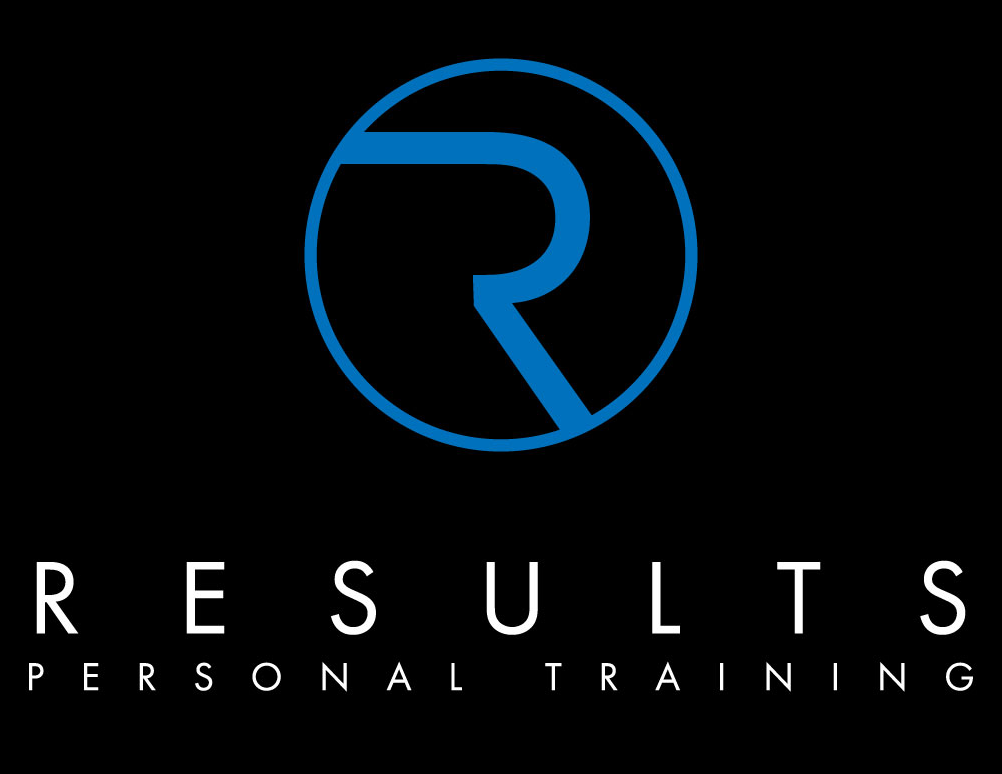
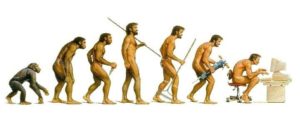
Recent Comments